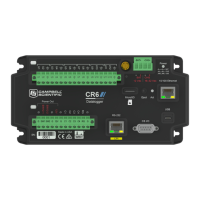measurement measures the high signal with reference to ground; the low signal is tied to
ground. A differential measurement measures the high signal with reference to the low signal.
Each configuration has a purpose, but the differential configuration is usually preferred.
In general, use the smallest input range that accommodates the full-scale output of the sensor.
This results in the best measurement accuracy and resolution (see Analog measurements
specifications (p. 216) for more information).
A set overhead reduces the chance of overrange. Overrange limits are available in the
specifications. The data logger indicates a measurement overrange by returning a NAN for the
measurement.
WARNING:
Sustained voltages in excess of ±20 V applied to terminals configured for analog input will
damage CR6 circuitry.
6.1.1 Single-ended measurements
A single-ended measurement measures the difference in voltage between the terminal
configured for single-ended input and the reference ground. For example, single-ended channel
1 is comprised of terminals U1 and . For more information, see Wiring panel and terminal
functions (p. 5). The single-ended configuration is used with the following CRBasic instructions:
l
VoltSE()
l
BrHalf()
l
BrHalf3W()
l
TCSE()
l
Therm107()
l
Therm108()
l
Therm109()
l
Thermistor()
See the CRBasic Editor help for detailed instruction information and program examples:
https://help.campbellsci.com/crbasic/cr6/.
6. Measurements 65

